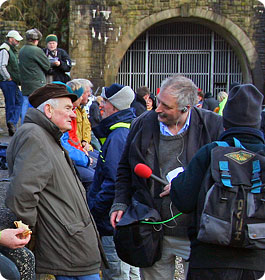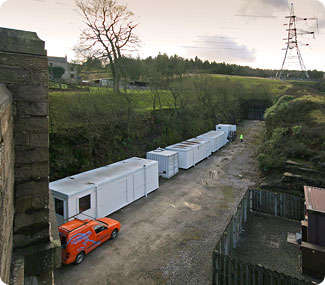Woodhead succumbs to tunnel vision

- Author: Graeme Bickerdike
- Source: The Rail Engineer
- Published: February 2008
Woodhead succumbs to tunnel vision
God created Saturday afternoons for football. Then Sky Sports came along and changed the world. Out went terraces and crunching tackles; in came executive boxes and Oscar-winning playactors. Think back to the Seventies – their sideburns might have defied all logic but our sporting heroes knew the right way to play. Oh how I long for Nobby Stiles.
Nobody should venture near one of today’s soulless stadia without first seeking financial advice. I apply the same rule when the wife suggests a shopping expedition. All of which can leave me at a loose end on Saturdays. But not so on January 12th. The diary entry read ‘Woodhead demo’. At one o’clock, having pitted my wits against a madcap HGV driver thrashing over the Pennines, I found myself sheltering beneath a disused tunnel portal with an unlikely band of brothers – air travel objectors, an MEP, ‘friends’ of the Peak District and a tambourine player. He refused to perform for me.
This was a big day for the alliance of transport and environmental campaigners who’ve rapidly come together to oppose the National Grid’s use of Woodhead New tunnel as a conduit for power. Around 60 of them gathered in its shadow to make their feelings known. Beyond a fence, Manchester’s 400kV electricity feed – kindly donated by a Yorkshire power station – gently hummed. It’s this supply which is the bone of contention, or at least NG’s plan to move the cabling from one of two Victorian single bores into British Rail’s comparatively spanking 1954 structure.

Photo: John Quick collection
Woodhead’s original tunnel – costing £60,000 and 26 lives – first welcomed trains three days before Christmas 1845. Seven years later, a second was added. Maintenance proved burdensome. When electrification of the line was reaching its climax in the late 1940s, their condition had deteriorated to such an extent that cutting a new hole through the hill had become the only sane option. So began a mammoth civil engineering project which sucked £4.6million from the Chancellor’s pocket.
The Central Electricity Generating Board acquired the redundant singles in the Sixties to hide a trans-Pennine power line, lessening its impact on the landscape of the Peak District. When the line finally shut up shop in 1981, BR’s tunnel also fell into its hands. Now, having poured £15million into the black hole of repair work, the National Grid wants to reap the benefits of its other asset next door. The cables are almost life-expired so the need for new furniture makes a move eminently sensible.

But not to those who want the railway back. Many of the protesting masses – and I use the term loosely – made the journey to Woodhead on foot and bicycle along the Longdendale Trail which occupies the former trackbed. It was a six mile trek from Hatfield station. Despite the weathered appearance of some, they were all substantially fitter than your reporter who, like the rest of the media horde, abandoned his vehicle within spitting distance of the tunnel. TV, radio and print hacks all turned out.
So what’s the protestors’ bottom line? They want to see the new tunnel safeguarded for future railway use. NG’s work would effectively rule that out as train and cable could not cohabit. Leaving aside their restricted gauge, bringing the singles back to good health would not be financially viable.


Rail freight growth of almost 30% is expected over the next decade. It could double within 30 years. The government’s strategic plans envisage no relaying of old lines to meet this demand. Instead increased capacity will somehow be extracted from our existing network. Yet there’s a contrasting view at regional level. Recent transport studies have endorsed the need for more tracks across the Pennines, identifying Woodhead as the logical route.
The Northern Way is a collaboration of three development agencies. Its chair is Neville Chamberlain – bizarre but true. He reckons that “if the future use of the Woodhead Tunnels for rail is not assured, the need to construct a major new tunnel across the Pennines could thwart the ambition of a new higher speed line ever happening. Additional, faster capacity across the Pennines will be critical to the economic future of the North.” So the stakes are high then.
Chris Davies, who represents the North West of England in the European Parliament, accuses the UK government of lacking joined-up thinking. He rhetorically asked his Woodhead audience “just how far behind does this country have to go in infrastructure terms before Ministers start to plan for the future? The government seems to hope that this country’s transport problems will just go away. There’s no evidence that that’s going to happen.”

For the National Grid, political handbagging has little relevance. It has been told by the Department for Transport that the tunnels are surplus to requirements. On that basis, it’s taken the financially sound decision to put a discarded resource to good use. Environmentalists support recycling, don’t they?
Which is why the protestors’ argument is not really with NG. They insist that “With competing demands for use of the tunnel, there must be a full appraisal of its future and an informed decision as to its most sustainable use for the 21st Century. To date there has not been an open, full dialogue with all appropriate stakeholders such as regional planners, the rail industry and its operators, and local people. We are calling for this to happen.”
Their campaign is building a head of steam. An Early Day Motion calling on the government to “prevent this strategic route being lost forever” has attracted the backing of 55 MPs. Local councils, Passenger Transport Executives and several green groups have also answered the call to arms.

This amassed muscle is causing Ruth Kelly to reach for her paracetamol but can it force NG into an eleventh hour retreat? Time will tell. Whatever the outcome, it would be a victory for common sense if this skirmish spawned a national strategy to assess and, where appropriate, protect the footprints of our retired network.
A South Yorkshire colliery recently rose from the dead courtesy of a 300% increase in wholesale coal prices. Who would have bet on pits being reopened 20 years ago? The fact is that we don’t know what the future holds or just how valuable our abandoned railway assets might yet become. It’s time the blinkers came off.





